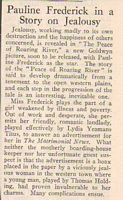

The Peace of Roaring River (1919) Goldwyn Pictures Corp. Distributor: Goldwyn Distributing Corp. Director: Hobart Henley and/or Victor L. Schertzinger. Scenario: George E. Van Schaik. Story: George E. Van Schaik. Camera: Edward Gheller. Cast: Pauline Frederick, Hardee Kirkland, Corinne Barker, Lydia Yeamans, Edwin Sturgis, Thomas Holding. 5 reels. This film appears to be LOST
 |
An unidentified clipping describing the film |
See also a still at the Silent Film Still Archive, and also also a Lantern Slide advertising this film from the collection at the Cleveland Public Library
| Madge Nelson | Pauline Frederick |
| Hugo Ennis | Thomas Holding |
| Nils Olsen | Hardee Kirkland |
| Sophie McGurn | Corinne Barker |
| Widow McBirney | Yeamans Titus |
| Kid Follansbee | Edwin Sturgis |
Thanks to some amazingly bad exhibitions of judgment on the part of Victor L. Schertzinger, who directed, and was ably assisted in lessening the picture's value by boneheaded film editing, "The Peace of Roaring River," a Goldwyn feature, with Pauline Frederick in the leading role, shown at the Rialto this week isn't anywhere near as good a feature as it should have been. It is full of loose ends, of motives inadequately accounted for, of threads of pictorial narrative left half told. To begin with, it starts wrong.
For the sake of getting Miss Frederick herself into the first fifty feet, where she has no possible business, the natural evolution of the story is caught up and bent back on itself. It should have begun with scenes on the Roaring River. The locale should have been developed and established. Then, in the natural course of events, Miss Frederick should have been introduced and the facts that make her appearance important developed on the screen. To tell the story the right way, it should be noted that Hugo Ennis is something of a woman-hater. Just why Hugo hates them Mr. Schertzinger does not inform us, but , accepting the plain statement at face value, we see him scorning the local postmistress.
Intent of revenge, she advertises him as a good prospect in a matrimonial paper. A poor little girl (Miss Frederick), so ill that she has to get into the country, falls for the chance to marry a mine-owner, and is lured on to Roaring River. Arriving there, she is taken out to Ennis's place only to find that he is away. All night she waits. When he comes in, knowing nothing of the reasons for her coming, he taunts her as a blackmailer, refusing to let her leave. In her fear and horror, she shoots him, then runs to stop the train, taking a splendid fall down a steep cliff to catch it. By the engine crew she sends for the doctor.
He comes. It seems Ennis is not badly hurt, and already warming toward the girl, he declares he shot himself by accident. But that does not satisfy the townspeople. Inflamed by the jealous postmistress, they set out to run the girl out of town. Ennis again saves her, and sends for the parson to perform the ceremony. A swift courtship, this--much too swift to be convincing. In fact, the most convincing thing about the picture is Miss Frederick's simple, direct method.
Loed.
"The Peace of Roaring River," at the Rialto this week, is the best photoplay in which Pauline Frederick has appeared recently. Not only is Miss Frederick's performance above her average, but the treatment of the story distinguishes it from the common run. For this treatment, Victor L. Schertzinger, whose work is familiar through a number of Charles Ray's pictures, apparently is responsible. It seems that this is the first time, in late years at any rate, that he has directed a picture for Miss Frederick, but it should not be the last. He seems to bring out the best of Miss Frederick's abilities, and his skill in making scenes expressive in themselves adds greatly to the effectiveness of a story.
Miss Frederick has worthy support, especially from Thomas Holding as the Western hero, Hardee Kirkland as his friend, Corinne Barker as the villainess, and Lydia Yeamans Titus as a lodging-house keeper.
In itself the story is simply a plot. Madge Nelson is discharged from a city hospital with the injunction that she must live in the country. She is poor, however, and cannot get out of the city. On her landlady's advice she answers a matrimonial advertisement and enters into correspondence with one whom she supposes is Hugo Ennis, a miner in Nevada. She finally goes West to marry him, but learns he had not inserted the advertisement and had never heard of her. A girl of the town, angered by Ennis's lack of interest, had arranged everything in order to humiliate him. Of course it all ends happily.
Last revised, December 25, 2008